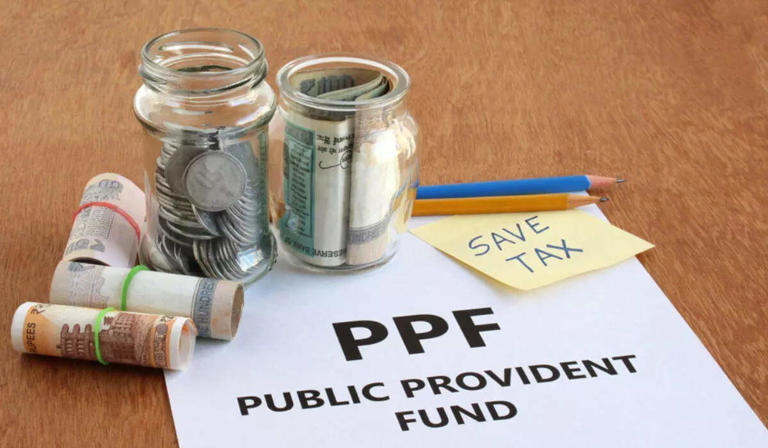When it comes to long-term investments that promise safety, stability, and tax-free returns, the Public Provident Fund (PPF) in India is an unsung hero. It’s one of the most reliable government-backed savings schemes out there, offering secure returns for those who have the patience to let their money grow over time. But how much can you actually earn if you start investing in the PPF today? Specifically, if you contribute Rs 2,000, Rs 6,000, or Rs 10,000 every month, what kind of returns can you expect in 15 years?

PPF 15-Year Returns Revealed
| Monthly Investment | Total Investment (₹) | Estimated Interest Earned (₹) | Maturity Value (₹) |
|---|---|---|---|
| ₹2,000 | ₹3,60,000 | ₹2,90,913 | ₹6,50,913 |
| ₹6,000 | ₹10,80,000 | ₹8,72,740 | ₹19,52,740 |
| ₹10,000 | ₹18,00,000 | ₹14,54,567 | ₹32,54,567 |
Investing in PPF is a smart move for anyone looking for a safe, reliable, and tax-efficient way to grow their money over time. Whether you’re contributing ₹2,000, ₹6,000, or ₹10,000 every month, you can watch your investment grow significantly over 15 years, thanks to the power of compounding and tax-free returns. Plus, the added benefit of tax deductions makes it an even more attractive option for investors of all kinds. So, if you’re planning for the future, PPF should definitely be part of your strategy.
Important Factors to Remember:
- Interest Rate: As of now, the interest rate on PPF is 7.1% per annum.
- Tax Benefits: Contributions up to ₹1.5 lakh per year are eligible for tax deductions under Section 80C of the Income Tax Act.
- Compounding: Interest is compounded annually, meaning you earn interest on your initial investment and the interest you’ve already earned, leading to exponential growth over time.
- Flexibility: You can contribute monthly or in lump sums, as long as you don’t miss the minimum contribution requirement of ₹500 annually.
What is PPF and How Does It Work?
The Public Provident Fund, or PPF, is a long-term investment scheme introduced by the Government of India. It’s primarily designed to help individuals save for their retirement, but it can also be used for other long-term financial goals. Here’s how it works:
- Minimum and Maximum Contribution: The minimum contribution to a PPF account is ₹500 per year, while the maximum you can invest is ₹1.5 lakh annually. You can invest in a lump sum or make monthly installments, as long as they don’t exceed the yearly limit.
- Interest Rate: The interest rate on PPF accounts is set by the government and is revised quarterly. As of now, it stands at 7.1% per annum, compounded annually.
- Maturity Period: PPF has a fixed maturity period of 15 years, but you can extend it in blocks of 5 years if you need to. After the 15-year mark, you can withdraw the entire amount or continue the account if you wish.
- Tax Benefits: One of the biggest attractions of PPF is its tax-free status. The contributions you make to a PPF account are eligible for tax deductions under Section 80C of the Income Tax Act, up to a limit of ₹1.5 lakh per year. Additionally, the interest you earn and the maturity amount are completely tax-free.
What Returns Can You Expect From PPF?
Now that you know the basics, let’s get to the juicy stuff—how much will you earn if you start investing ₹2,000, ₹6,000, or ₹10,000 every month? To make things easy, let’s break it down year by year and look at what your total investment and returns might look like after 15 years.
Monthly Investment of ₹2,000
Let’s say you start investing ₹2,000 every month for the next 15 years. Over the 15-year period, you will have invested a total of ₹3,60,000 (₹2,000 × 12 months × 15 years). With the current interest rate of 7.1%, your total returns, including interest, will amount to around ₹6,50,913. This means that the ₹3,60,000 you invested will grow by ₹2,90,913 in 15 years, making it an excellent long-term investment choice.
Monthly Investment of ₹6,000
Now, if you decide to invest ₹6,000 every month for 15 years, your total investment will amount to ₹10,80,000 (₹6,000 × 12 months × 15 years). With the 7.1% interest rate, you can expect your investment to grow to approximately ₹19,52,740. This means your ₹10,80,000 investment will earn you about ₹8,72,740 in interest over 15 years, giving you a much bigger payoff compared to the smaller monthly contribution.
Monthly Investment of ₹10,000
For those who are able to invest ₹10,000 each month, you’ll be contributing a total of ₹18,00,000 over the 15 years. At the same 7.1% interest rate, the maturity value of your PPF account will be around ₹32,54,567. This means you will earn ₹14,54,567 in interest alone, which is quite substantial. For higher earners or those aiming for a larger retirement corpus, this is an ideal option.

The Power of Compounding and Interest Rate Changes
One of the key reasons PPF is so effective is the power of compounding. Interest on your PPF investment is compounded annually, meaning the interest you earn each year gets added to your principal, and the next year’s interest is calculated on the new total. Over 15 years, this compounding effect works wonders in growing your investment.
However, it’s important to note that the interest rate on PPF can change every quarter, based on the government’s decisions. If the interest rate rises during your investment period, you stand to earn even more, whereas a decrease in the rate could slightly reduce your returns. Despite these fluctuations, PPF remains a solid investment, as the government guarantees the interest rate and the safety of your capital.
Tax Benefits: A Cherry on Top
One of the main reasons people choose PPF is for its tax benefits. Not only do you get tax deductions on the contributions you make under Section 80C, but the interest earned and the maturity proceeds are completely tax-free. This is a significant advantage over other types of investments that may attract capital gains tax or other forms of taxation.
For example, if you invest ₹6,000 every month in a PPF account, you can claim a tax deduction of ₹72,000 per year (₹6,000 × 12) under Section 80C. This can be a massive tax-saving tool, especially for those in higher income brackets.
Flexibility in Contributions
One of the best things about PPF is its flexibility. While it has a fixed maturity period of 15 years, you have the freedom to decide how much to invest each year, provided it doesn’t exceed the annual limit of ₹1.5 lakh. You can make monthly or lump sum contributions, and you don’t have to worry about penalties if you miss a few payments. However, you’ll want to make sure you’re consistently contributing to maximize your returns.
FAQs
1. Can I withdraw my PPF balance before 15 years?
- You can make partial withdrawals from your PPF account after the 6th year. However, early withdrawals are restricted to a certain percentage of the balance.
2. Can I extend my PPF account after the 15 years?
- Yes, you can extend your PPF account in blocks of 5 years after the initial 15-year term.
3. What happens if I miss a PPF contribution?
- If you miss a payment, your account may become inactive. However, you can revive it by paying a penalty fee and the missed contribution amount.
4. Is PPF a good investment option for retirement planning?
- Absolutely! PPF is one of the best retirement savings options due to its safety, tax benefits, and guaranteed returns.









